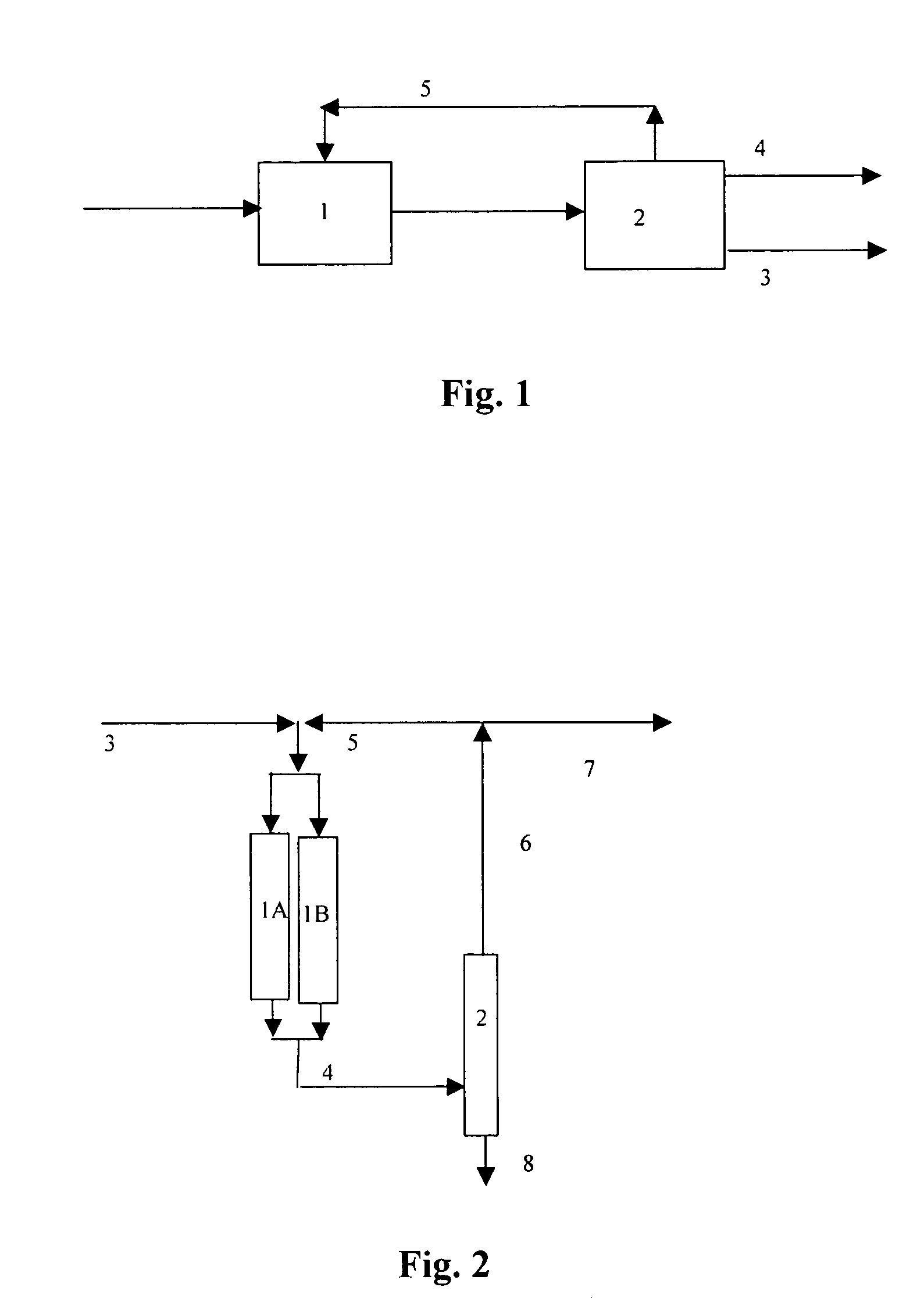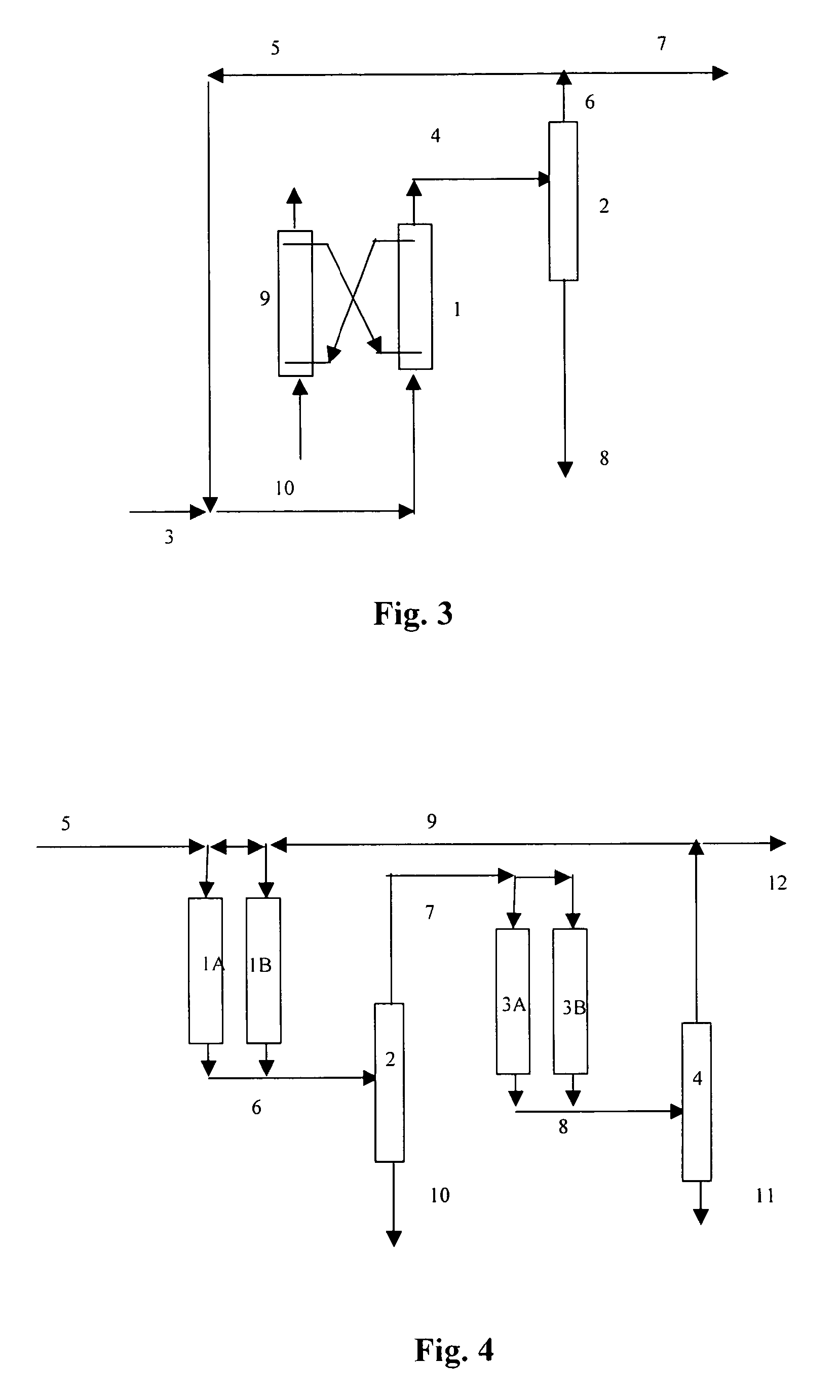Process for dimerizing light olefins
a technology of light olefins and dimerization processes, which is applied in the direction of detergent dyes, detergent compounding agents, organic chemistry, etc., can solve the problems of difficult hydrogenation of dimerized products, no known solution provides dimerization at high selectivity, and high undesired, so as to save process equipment investment, simplify and simplify the design of process equipmen
- Summary
- Abstract
- Description
- Claims
- Application Information
AI Technical Summary
Benefits of technology
Problems solved by technology
Method used
Image
Examples
example 1
[0091]Comparative example with commercial ion exchange resin catalyst. The present invention does not include the catalyst.
[0092]Isobutene is dimerized continuously in a reactor tube at temperature 80° C. and at pressure 20 bar. The catalyst used in reaction was a commercial ion exchange resin used in the commercial dimerization process. The catalyst load was 9.4 g dry catalyst. Before loading into the reactor tube the catalyst was rinsed with deionized water and dried in oven 110° C. for 16 hours.
[0093]The feed contained 30 wt-% isobutene and 70 wt-% isobutane, but no polar components. The flow rate of the feed was 100 g / h.
[0094]Table 2 presents the results of the example 1. The results showed that conversion of isobutene was very high but the selectivity to dimers was poor.
[0095]
TABLE 2Summary of the results for example 1Conversion of isobutene, %99.8Selectivity to dimers, %12.72,4,4-trimethylpentenes, wt-%3.1C8-olefins, wt-%4.3C8+, wt-%29.4
example 2
[0096]Comparative example with commercial solid phoshoric acid catalyst used in the commercial dimerization process. The water in feed is required for activation of catalyst.
[0097]
TABLE 3The test conditions for example 2Examples2a2b2cWHSV, Total (g feed / g catalyst * h)3.475.7WHSV, Isobutene (g isobutene / g catalyst * h)0.71.41.2Feed20 wt-% isobutene,31 wt-% n-butane,48 wt-% iso-octaneWater content of feed, ppm100Temperature, ° C.138140140Pressure, bar212131
[0098]
TABLE 4Summary of the conversion and selectivities for example 2Example 2aExample 2bExample 2cConversion of97–9896–9898isobutene, %Selectivity to77–7980–8584–86dimers, %
example 3
Comparative Examples with Zeolite Catalyst
[0099]The catalyst was ZSM-5 zeolite in proton form. Its Si / Al-ratio was 24, BET-surface area 550 m2 / g, crystallinity 80% and particle size less than 0.001 mm. The feed had 39% isobutene.
[0100]The conditions for comparative examples are presented in Table 5.
[0101]
TABLE 5The experimental conditions of comparativeexamples with zeolite catalyst.Example 3aExample 3bExample 3cTemperature, ° C.150100100Pressure, bar101010WHSV, 1 / h4420
[0102]
TABLE 6Summary of the conversion and selectivities for example 3Example 3aExample 3bExample 3cConversion of97–9898–10016–70isobutene, %Selectivity to40–4820–35 45–77dimers, %
PUM
| Property | Measurement | Unit |
|---|---|---|
| temperature | aaaaa | aaaaa |
| pressure | aaaaa | aaaaa |
| vapour pressure | aaaaa | aaaaa |
Abstract
Description
Claims
Application Information
 Login to View More
Login to View More - R&D
- Intellectual Property
- Life Sciences
- Materials
- Tech Scout
- Unparalleled Data Quality
- Higher Quality Content
- 60% Fewer Hallucinations
Browse by: Latest US Patents, China's latest patents, Technical Efficacy Thesaurus, Application Domain, Technology Topic, Popular Technical Reports.
© 2025 PatSnap. All rights reserved.Legal|Privacy policy|Modern Slavery Act Transparency Statement|Sitemap|About US| Contact US: help@patsnap.com


